A former fishing village that became a seaside resort in the 1970s, Saly, in Senegal, is seeking solutions to the decline in international tourism.
Saly: in the imagination of many European tourists and retirees, and particularly French, the very name of this former small Senegalese coastal village, located on the Petite-Côte, some 90 km south of Dakar, evokes the typical model of the seaside resort.
This view is now somewhat outdated. In Saly, economic and social life has long been based on the dynamism of hotel complexes and other famous holiday clubs managed by major tour operators. This model, which was already running out of steam, was deeply affected by the Covid-19 pandemic. Some historic hotels are abandoned, the main restaurant is closed and the original shopping center lives on.
However, far from withering away, the city is changing, attracting more Senegalese customers, while the forms of European presence are gradually changing.
The decline of mass tourism
The 2019 global health crisis prompted EU tourists to opt for less distant destinations than previously. And this trend towards “local” tourism seems to continue.
Tourism practices have evolved into new forms, such as digital nomads (those people who choose to work remotely, often from a resort), which correspond less to the standards of mass tourism. New travelers frequent clubs less and their needs are now moving further and further away from the model “Sea, sun and sand”.
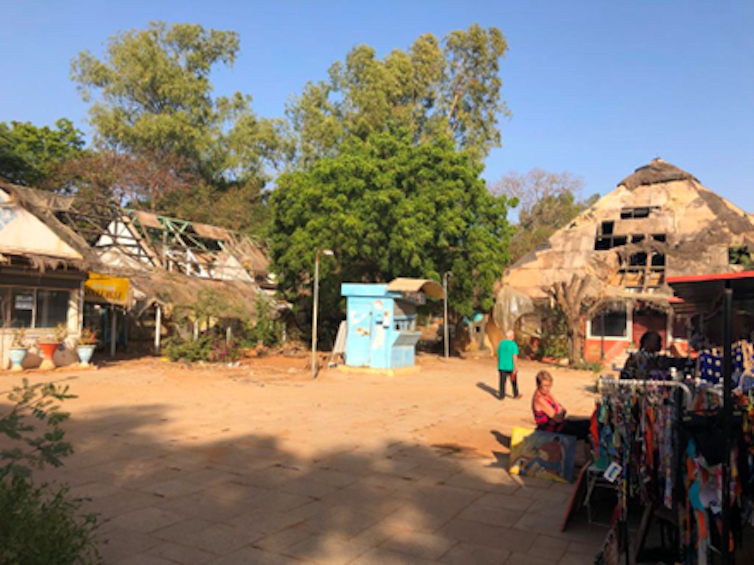

Sébastien Fleuret/UMR ESO-Angers, Author provided
The pandemic has also generated a domestic tourism growth. Senegal, having been one of the first countries to close its borders at the time of the epidemic, Senegalese tourists reclaimed coastal seaside areas deserted by Europeans. Some high-end hoteliers report that at the time of the confinements, they developed a promotional offer mainly addressed to a Dakar clientele in order to ensure a minimum of activity in their establishments.
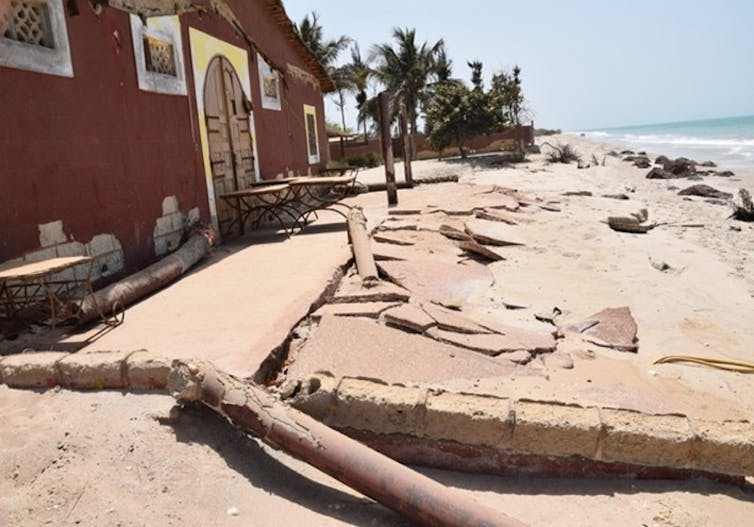

David Lessault/UMR ESO Angers, Author provided
The trend has confirmed the attractiveness, which has been on the rise for two decades, that coastal areas arouse among Dakar residents. Every weekend, access to the only beach in Saly that has a car park is taken over by hundreds of families coming from Dakar and owning a second home or staying in rented accommodation in surrounding inns. The inhabitants take advantage of this to set up ephemeral eateries where grilled fish, fruit and other juices are sold. For a weekend, the Senegalese seem to regain their rights, while during the week this beach is rather frequented by tourists and European residents, or is even exclusively reserved for them.
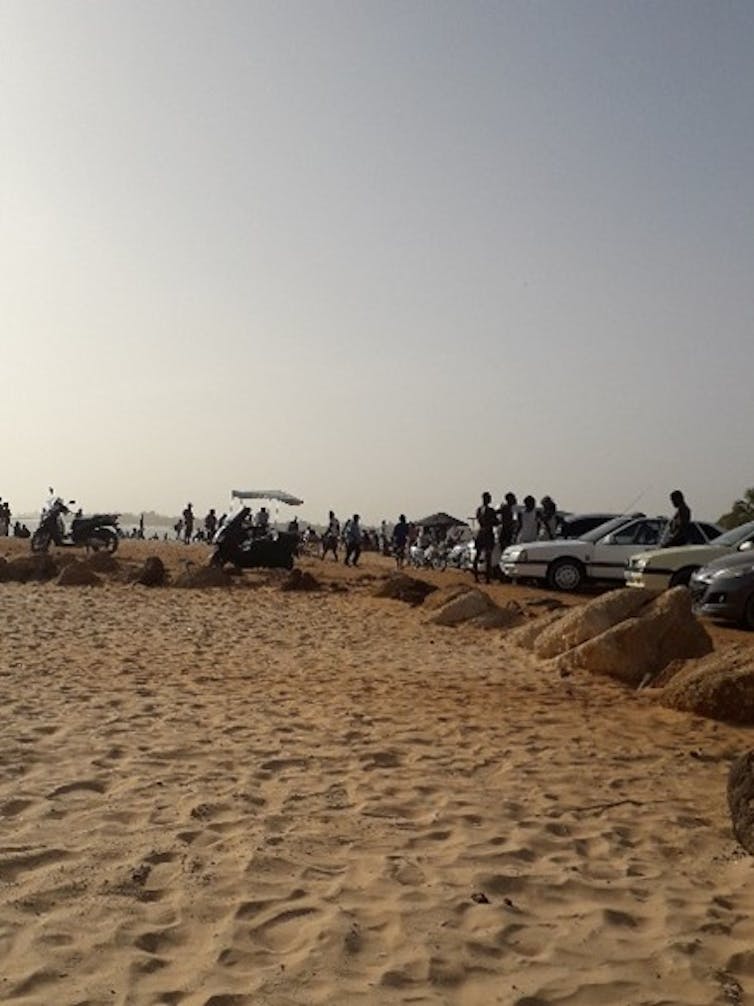

David Lessault/UMR ESO-Angers, Provided by the author
New forms of European presence
If the model of the seaside resort dedicated to international tourism seems to have had its day, other European presences have established themselves locally. At first, Saly did not escape, like many destinations in the South, the arrival of retired French people who came to spend the "warm winter". For single retirees, these long stays are sometimes associated with the search for a life project as a couple in Senegal, preferably with a younger partner. These steps are quite frequent and fully assumed despite the unapproving gaze of the local populations, who sometimes see it as an immoral practice given the great differences in age and resources.
Still, the phenomenon has developed since the early 2000s and is mainly located in a dozen closed collective residences that swarm to the south of the former seaside resort. The autonomy of these new residents, compared to those of hotels and clubs, gave birth to a new local economy oriented towards access to food (multiplication of supermarkets, large brands), residential services (women cleaning, security, pool maintenance, etc.) and catering (bars, restaurants). This second form of Saly's expansion now seems to be diluted in turn by the development of new residential extensions to the north and south of the town.
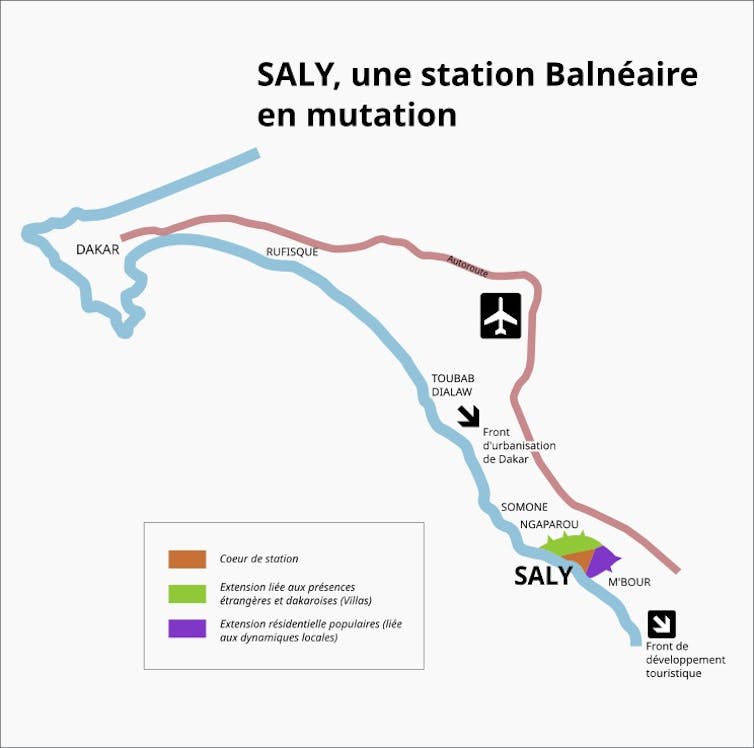

Sébastien Fleuret/UMR ESO-Angers, Provided by the author
In the early 2020s, new settlements transformed the local landscape. Alongside hotel complexes and closed collective residences for retirees appear new residential spaces built in a more anarchic way on the model of the individual villa or group of villas. This mode of expansion is boosted by the more recent arrival of European entrepreneurs.
Armelle and Hervé (first names have been changed) rented a furnished villa by the sea at the time of the Covid to escape confinement in France. Their stay decided them to come and settle permanently in Saly. They left their network of ready-to-wear shops in France to manage them to come and develop new businesses in Senegal. After a first real estate purchase on the coast to the north of the resort, they are now planning to move to the recent extensions of a district with the evocative name "La Piste des billionaires", where constructions are multiplying around the golf course, towards the interior, cutting back on the cultivation areas of the surrounding villages.
[Nearly 80 readers trust The Conversation newsletter to better understand the world's major issues. Subscribe today]
Many young entrepreneurs quickly identified the consumer needs of this new upscale population of Saly. Jean has just opened a fast food restaurant on the city's main thoroughfare. Its hamburgers are sold at prices found in Europe with “organic” products guaranteed “freshness”. He targeted his customers well. The sector in which he operates mainly concentrates European residents, mainly Belgian and French, and secondary residents of the Dakar elite and Lebanese. We also find in his clientele Senegalese formerly emigrated back from Europe. The latter have appropriated the tourist practices of the countries of immigration and are more and more numerous to invest in real estate on the Petite Côte.
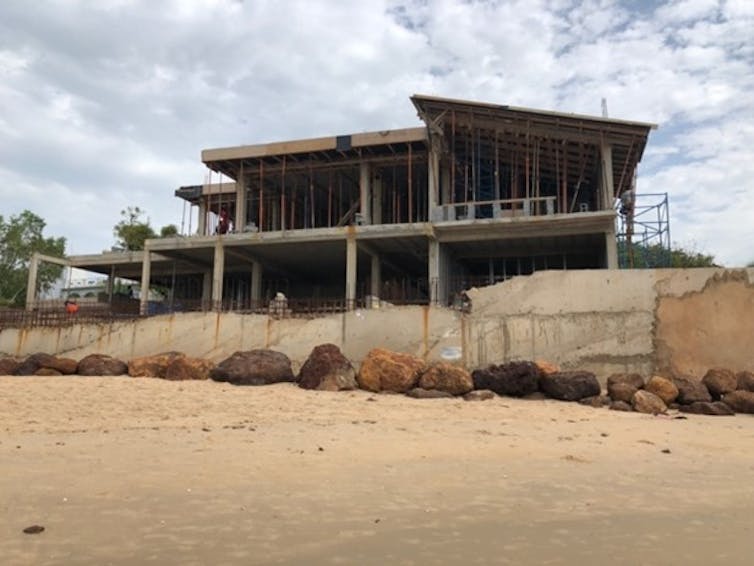

David Lessault/UMR ESO Angers, Provided by the author
With the development of the individual villa model, which breaks with the classic hotel model, new activities are emerging in different areas. We observe, for example, the proliferation of shopping centres. Sidy, who lived 35 years in France, launched his retail brand to compete with international groups that are opening stores throughout Senegal and even more so in Saly. Jean has set up a burger home delivery offer to diversify his fast food clientele. This Western business model, which is relatively underdeveloped in the region, is very successful. Other activities are emerging under the effect of European presence. This is the case of paddle, this racket game imported from Spain, which brings together fans exclusively of European origin.
The evolution of landscapes
These recent trends have a significant impact on landscapes. They result in the proliferation of construction sites, participate in the rapid expansion of the area of villas while operating the junction to the north with the Dakar urbanization front. This axis (green area on the map) is mainly driven by investments from Europeans and the Senegalese diaspora.
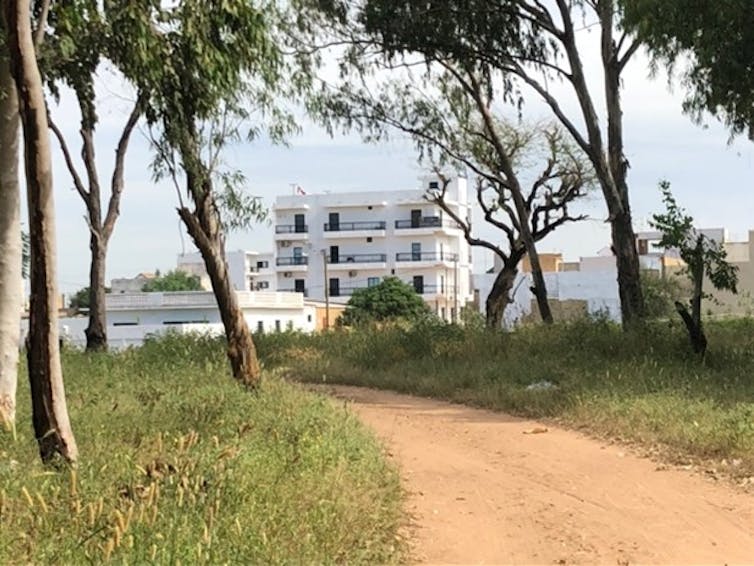

David Lessault/UMR ESO Angers, Provided by the author
New constructions are in full development on the coast towards Ngaparou. On this axis, the urbanization is continuous until Somone. It is also in the field of peripheral agricultural land, towards the interior (towards the highway), that large villas and private residences flourish. This is where the “billionaire track” mentioned above is located.
Further south and inland, the expansion, which is also very rapid, is fueled by migrants from Senegal or the sub-region (Gambia, Guinea, Niger, Mali, Mauritania). The latter are attracted by the job prospects generated by this sudden local development and seek to settle near their place of work. They thus participate in the urbanization of the “Saly Carrefour” district which now joins the neighboring town of M'Bour (purple area on the map).
Every morning, the road linking M'Bour to Saly is taken over by informal taxis (known as “clandos”) transporting domestic workers to residential areas. Ibrahim, hired by French owners to oversee a group of 23 villas, has to take three different means of transport to come to work. This represents more than an hour of transport and a quarter of his meager salary (70 CFA francs per month, evening a little over 000 euros) deducted each month to reach his place of work, six days a week.
In a way, the rapid expansion observed in the well-to-do residential sector towards the north of the municipality and in that of the popular extensions towards the east and south further distances the local and European populations from each other. It thus reinforces segregation and complicates access to employment for local workers who do not have the resources to find accommodation on site.
Saly's expansion dynamics initially stimulated by the state from the 1970s through the promotion of international seaside tourism, then through the implementation of major infrastructure projects (new airport, toll motorway) is today relayed by the proliferation of new private players. Several models of European presence now co-exist: that of declining hotel complexes, gated residences for seniors, individual villas for entrepreneurs and the Senegalese diaspora. On the sidelines, new working-class neighborhoods are developing towards the south and the interior in place of the old villages. On either side of the old heart of the station, these two forms of extension with very contrasting social content participate in the original creation of a satellite city of Dakar that has become cosmopolitan.![]()
![]()
Sebastien Fleuret, CNRS research director, health geographer, University of Angers; David Lessault, Researcher at the CNRS, specialist in international migration and mobility, University of Angersand Pope Sakho, CAMES Lecturer, Cheikh Anta Diop University of Dakar
This article is republished from The Conversation under Creative Commons license. Read theoriginal article.










































![[Editorial] 30 years later, is apartheid really over?](https://lejournaldelafrique.com/wp-content/uploads/2021/06/caricature-jda-apartheid-360x180.jpg)
![[Edito] Gabon and Commonwealth: the whims of Prince Ali](https://lejournaldelafrique.com/wp-content/uploads/2021/06/caricature-JDA-Bongo-360x180.jpg)
![[Editorial] Facebook and Twitter, more dictators than dictators?](https://lejournaldelafrique.com/wp-content/uploads/2021/06/Caricature-JDA-FB-TW-360x180.jpg)
![[Edito] Rwanda: for the French apologies, we will have to go back](https://lejournaldelafrique.com/wp-content/uploads/2021/05/Caricature-rwanda-JDA-360x180.jpg)
![[Edito] Guinea: Alpha Condé, the oppressed turned oppressor](https://lejournaldelafrique.com/wp-content/uploads/2021/05/Caricature-Alpha-Conde-360x180.jpg)
![[Edito] CFA Franc: a facelift cut to measure for France](https://lejournaldelafrique.com/wp-content/uploads/2021/05/Caricature-JDA-CFA-360x180.jpg)
![[Edito] Riyad Mahrez: One, two, three, viva l'Algérie!](https://lejournaldelafrique.com/wp-content/uploads/2021/05/caricature-Mahrez-360x180.jpg)
![[Edito] Niger: Mohamed Bazoum begins a delicate balancing act](https://lejournaldelafrique.com/wp-content/uploads/2021/04/image_6483441-1-360x180.jpg)
